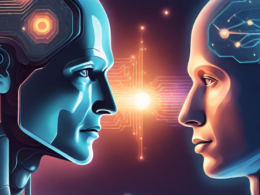So you’ve heard the words Machine Learning and Data Mining been thrown around in conversations.
You might have used them interchangeably.
Lines are blur all over, right?
Not quite… Honestly, if you’re struggling with the distinction between these two terms, there is a high chance things will get irreversibly confusing in the distant future.
On the bright side, if you do need your understanding of machine learning and data mining to be more absolute, you’re at the right place! We get that making sense of words in a world of constant noise can get hard, but we’ve got you covered. We advise you to read on to clear the air on some popular terms.
Where do we begin?
The relationship between machine learning and data mining is not black and white. They’re neither subsets of each other nor polar opposite concepts. To explore their relationship, we need to walk through some basics.
It all begins with data. Data can be structured or unstructured.
Let’s explain through an example. I have a LOT of books. Say you had to classify all the books I own in a way that it’s easier for me to browse through my collection.
You make a list of the books with their names, names of the authors, genre, total number of pages and serial numbers. Congratulations, you just created data! What’s more, is that you created structured data!
If I have such a list I can easily arrange or pick or suggest books using any of the categories you created earlier.
Now, what happens when I ask you to help me out with my collection only this time, you have no access to my books. All I give you are pictures of their front covers. It’s hard making that work, right?
This is unstructured data. Typical examples of unstructured data are text, images and video files. Unstructured data is hard to process, classify and make sense of, in general.
Around 80% of the data we generate is unstructured.
So there’s obviously much more work and scope in unstructured data. Structured data finds a place in databases because there is some form and structure to it. A number of database management systems are used today to handle structured data.
Unstructured data requires a lot of techniques and tools to make sense of. Data mining is one of the popular techniques used.
Let’s walk through another example. Say suppose you want to know how a movie has been reviewed. In the website you use for booking movie tickets, you can review a movie by rating it out of five and adding some brief text about the experience.
Now two sets of data is getting collected, the ratings which are numbers out of 5 are structured data, the text review written by individual movie goers is unstructured data.
What is data mining?
Data mining is studying, understanding, identifying patterns in heavy, complicated data-sets. These data-sets need not be purely unstructured, as we know rarely in life do we ever come across something which is unconditional.
Data mining uses a number of different tools to derive insights from this data. One such tool is machine learning.
How to do Data Mining:
- Data collection: Gathering data from different sources
- Data integration: Converting data collected from various sources into a uniform output
- Data cleaning: Identifying and correcting incomplete, inaccurate and missing data
- Data processing: Converting raw data into a polished structure
- Data mining: Using approaches like clustering, classification, machine learning algorithms to uncover patterns and relationships
- Visualization and presentation of insights: Using visual tools to explain findings from data
- Decision making: Implementing insights in real-life situations to solve business problems

What is Machine Learning?
Machine learning is a machine’s ability to learn to solve a problem using instructions already fed to it and borrowing learning from similar, previous experiences. Machine learning uses algorithms to achieve this.
The problem with a machine or a system is that they need someone to feed them a structure to get a task done. Machine learning focuses on building such systems that machines can learn, to perform a number of different tasks with minimum human interference.
 Machine learning as a tool in data mining
Machine learning as a tool in data mining
Like we said, these two do not share a binary relationship. One of the aspects of their relationship is how machine learning serves the cause of data mining.
Consider our movie reviews example once again, the unstructured text-reviews collected over time are first cleaned and pre-processed for a machine to make sense of it. This includes removing extra spaces, punctuation and making data ready for a machine to read. This is data cleaning.
The next step would be data selection. Relevant reviews must be separated to work on. Irrelevant data, in this case, would be data that has nothing to do with a movie review.
The data is then transformed and mined as per one’s needs. In our case, the next step would be to deploy a machine-learning algorithm to cluster and classify these reviews as similar or good or bad.
If you want to know which machine learning algorithms should be picked for such tasks, you should read our previous article here. This is how machine learning fits into the process of data mining.
Data mining’s contribution to machine learning
We’ve discussed how machine learning works countless times!
System learns through data fed to it to develop its own ability to make decisions and solve problems like a human mind. The algorithm that is used to achieve this ability is trained on data or test data.
This learning-by-doing approach is what requires data mining. Data mining might be used to get the test data ready. This test data is used to train a given machine learning algorithm.
That’s a scenario where data mining serves its purpose towards machine learning.
How is Machine Learning similar to Data Mining?
Machine learning and data mining are both used for predictive modelling. Another similar application is sentiment analysis.
Predictive modelling predicts or forecasts outcomes and understands exactly what factors affect the said outcome. Sentiment analysis studies emotional undertones, attitudes, opinions from a set of data. This data is mostly in the form of text.
Machine learning and data mining use statistics, probability and algorithms as tools to make such predictions.
How is Machine Learning different from Data Mining?
Different Objectives
Data mining explores cryptic or mysterious data to find patterns and insights that might be useful. Machine learning uses algorithms to self-learn and replicate decisions without any help from an actual human brain.
Consider your friend asks you to go fishing in a lake. You have no knowledge of what purpose it serves and what you’re looking for. You cast your net in the water and catch a bunch of stuff. This bunch of stuff is your data. Then you go through your catch, throwing away trash. You realize the fish are edible and might be useful for you. This is the value served by data mining.
Now suppose your friend has taken a machine along on the same fishing trip. While you learn to fish on your own, he trains the machine to fish by following and replicating his actions. The machine learns as it observes his movements and improves. The next time, he sends the machine to fish for him. The machine replicates what it has learnt to catch fish and separate them from other useless things. This is the most ideal situation that machine learning can accomplish.
Standard Procedure Vs. Improvisation
The steps involved in data mining are relatively standard. Data is collected, integrated, cleaned, transformed and processed into meaningful insights.
In machine learning, the system is designed to improve on its learning. As the system is exposed to newer data-sets, it continues to learn and improve generating better predictions
Human intervention Vs. Autonomy
This is perhaps the most important distinction. Data mining is controlled and conducted by human effort. The entire process is supervised by the user and is not equipped to handle obstacles or interruptions on its own.
Machine learning is used to minimize human intervention. Machine learning algorithms are built to bring more autonomy to the system to make conclusions and perfect the process based on its previous experiences.
Possible end uses
Both data mining and machine learning are used to find patterns in the data and predict outcomes. However data mining is more suited in situations that require identifying relationships in the data for a particular use case.
Machine learning uses similar techniques to identify patterns and make predictions but is better suited to large sets of data incoming continuously so as to maximize the efficiency of the algorithms used.
This ends the comparative analysis of data mining and machine learning. We hope you can now differentiate between the two. It is important to understand the distinction to determine where you should use these two techniques. If you have any questions for us, do not forget to add them to our comments section.







1 comment